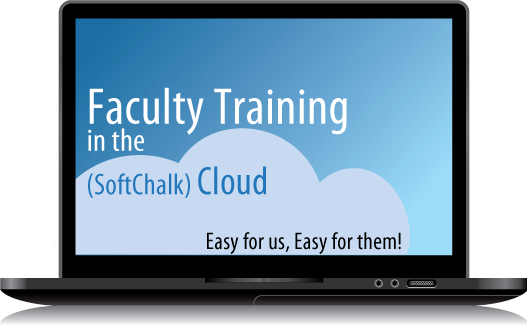Written by Laura Lawrence and Tracey DeLillo from the Alamo Colleges

When the Alamo Colleges District was searching for a new e-learning tool to serve their network of five colleges across San Antonio, they knew they needed a solution that would serve both students and faculty.
They also knew that any tool they chose would have to cater to the different ways in which people learn. They wanted to find a solution that would help them create e-learning courses that would allow them to teach a variety of students, as well as train faculty. They also knew they wanted students and faculty to be able to access course content both in the classroom and online.
Read on to learn more about why Alamo Colleges District chose SoftChalk Cloud as its preferred e-learning tool for creating a blended learning environment for both students and faculty.
eLearning Tools For Diverse Student & Faculty Needs
As traditional student coursework has made the move to an online environment, a great deal of thought has been given to the most effective ways to use technology without sacrificing engagement and outcomes.
Concurrent with this trend, though not necessarily related to it, is the broadening of student demographics. Students who were once considered “non-traditional” due to age, marital status, family and job responsibilities, or other characteristics have become more the norm than the exception, especially in community colleges. The lessons we are learning from these shifts are also applicable to the faculty training side of the house.
Challenges Of Training Different Types Of Faculty Quickly & Effectively
We have a diverse audience of faculty, many of whom fail to fit any academic stereotype. This can be a good thing or a not-so-good thing from a training perspective.
On one hand, we might have instructors fresh from grad school. These instructors are typically more comfortable with learning management systems and related technology. The likelihood is that they took one or more online classes during their education is much higher than some of our other instructors.
On the other hand, we have many adjuncts who have full-time jobs outside of their teaching duties. They may or may not possess advanced computer skills. However, we know that with their busy schedules, the time they have to devote to getting up to speed with new initiatives is definitely limited.
This training time crunch is also a factor for full-time faculty, whose “other duties” often seem to grow as their ranks shrink in favor of more adjuncts.
These are just a few scenarios. There are a head-spinning number of combinations when you consider the variables, such as:
- Faculty experience (pedagogical and technical)
- Access to resources (human and technical)
- Time constraints
- Motivation
- Need
To accommodate this wide range of variables, we have to carefully consider and evaluate any new tool or process that we might use for training.
Questions To Ask When Considering New Tools For Faculty Training
For each new tool or technique that we need to train faculty on, we must consider the following questions:
- Do all faculty have to learn and adopt this process, or just some? For example, should we only train those that teach classes that are fully online?
- Can this process be self-taught, or would it benefit from face-to-face and hands-on training from knowledgeable staff or professional trainers?
- How long will this process take to learn? Or how long will it take for faculty to familiarize themselves with a new tool?
- What level of technical expertise does a new tool or process require?
- How important is this tool or process for day-to-day course activities or long-term faculty development?
- Can the same training be utilized across the entire college district, or does it need to be campus-specific?
Once we’ve evaluated a new tool or process using this set of questions, we can start to consider how we’ll roll out training to any faculty members that need it.
An eLearning Tool That Goes The Distance
Access to training is an important issue for us. If the faculty audience for our training is a captive one, we can schedule a face-to-face session or utilize online tools behind firewalls or institutional authentications.
If we are targeting online faculty—especially those affiliated with more than one of our colleges, awaiting affiliation, or truly working from a distance—we have to make sure training is available in a place they can get to. This often means creating courses housed in an online environment, accessible from any location with an internet connection.
Thankfully, there are abundant and diverse online tools available to assist us with e-learning course creation. And as our professional development and teacher training staff dwindle, we are increasingly turning to e-learning content to make sure all of our faculty has access to necessary training.
Alamo Colleges District’s Suite Of eLearning Tools
To create, distribute, and track our faculty training, we use a variety of e-learning tools.
For instance, we use static tools, such as intranet repositories of documentation. We also have dynamic, synchronous tools such as Blackboard Collaborate and other web conferencing platforms.
For our blended learning needs, we have our learning management system (Canvas) and tools like SoftChalk Cloud. With SoftChalk Cloud, we can create attractive and engaging courses. We can choose to drive and measure that e-learning content with activities and assessments. We can also make the content purely informational, ensuring that our faculty can return to it for reference.
Using all of these tools, we’re able to train faculty both in-person and online. This flexibility helps us make sure that all faculty across our five campuses have the training they need to set our students up for success.
SoftChalk As Our Preferred Tool For eLearning Content Creation
SoftChalk has given us one flexible avenue for developing online training modules for our faculty. It has proven useful for creating appealing and engaging learning options. With its easy-to-use content creation tools, we can generate lessons and modules quickly and edit them on the fly.
We’re excited by the feedback we’ve gotten so far on SoftChalk and the possibilities for wider use at Alamo College District in the future.
Does SoftChalk Sound Right For Your Training Needs?
If you need to create e-learning content for your faculty, SoftChalk Cloud’s content creation tools can help you create high-quality, interactive, and engaging online courses. You’ll be able to train all faculty members, whether they work across multiple locations, work remotely, or were absent during an important professional development session.
See if SoftChalk Cloud is right for your e-learning needs by requesting your 30-day free trial.

Leave a Reply